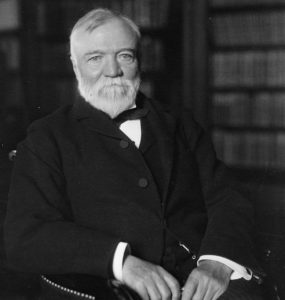A Legacy in the Making
Category: #Carnegie100, Blog
This blog post is part of our #Carnegie100 series, marking the 100th anniversary of Andrew Carnegie’s death and celebrating his libraries legacy.
A legacy in the making: Exploring Andrew Carnegie’s personal interest in public libraries
by Kirke Kook, Curator, Andrew Carnegie Birthplace Museum
Andrew Carnegie and his family arrived in Allegheny City (now part of Pittsburgh), Pennsylvania in September 1848. Nine months later, and only thirteen years of age, Andrew started working twelve-hour days as a bobbin boy at the Anchor Cotton Mills. Like many others at the time, he had very little formal education, having only attended school for four years in Dunfermline. Most of his early knowledge, including his love for Scottish history and literature, came from his family. Both his mother’s and father’s sides of the family were self-educated, well-read and active members of Dunfermline’s community. Interestingly, in the late-1880s, when Andrew Carnegie had already helped to build several public libraries in Scotland, he spotted an article in a Dunfermline newspaper which stated that his father William had been one of the three handloom weavers who formed the first free library system in the town. There is only tenuous proof to this story. However, as Scotland had a rich voluntarily-run library culture already back then, it is not impossible that that was indeed the case.
Carnegie’s discovery of Anderson’s Library
As a descendant of generations of self-taught men, Andrew Carnegie was eager to grasp every opportunity to improve his skills and knowledge. Although various subscription libraries had existed in Allegheny and Pittsburgh since 1813, there were no free public libraries there at the time. Andrew Carnegie was therefore delighted to learn in 1850 about the retired iron manufacturer Colonel James Anderson’s decision to open up his private library free of charge to the city’s apprentices and working boys on Saturdays. It is widely believed to have been Western Pennsylvania’s first public library. Carnegie was a frequent visitor to Anderson’s library. “The treasures of the world which books contain were opened to me at the right moment,” he wrote in his autobiography.
In 1853, when Anderson’s library ran short of funds, he firmly protested against the directors’ decision to introduce a two-dollar fee on all boys who were not formally bound by letters of apprenticeship. The 17-year-old Andrew’s letters of complaint to the editor of the Pittsburgh Dispatch yielded results and he was once again permitted to borrow one book a week without paying a fee. Colonel Anderson’s library’s loan records and some of his library books seem to have been lost over the years. Fortunately, in 1928, the Carnegie Free Library of Allegheny donated to the Andrew Carnegie Birthplace Museum twelve books that Andrew Carnegie had borrowed from Anderson’s library, some of which are on public display in the museum hall. Colonel Anderson’s generosity towards his local community was partly what inspired Carnegie to establish free public libraries.
The ultimate tool for ‘self-making’
However, unlike Colonel Anderson, Carnegie’s philanthropy transcended regional and national borders. He helped to set up public libraries throughout the English speaking world and beyond. Although Andrew Carnegie valued formal education (he even considered reading for a degree in Oxford in the 1870s), he argued that improving one’s knowledge by reading or through observation should be held at equally high regard. Unlike attending a college or working as an apprentice, visiting a library involved no external motivating force. It was the ultimate tool for self-making. “The fundamental advantage of a library is that it gives you nothing for nothing. Youths must acquire knowledge themselves. There is no escape from this,” he wrote in his autobiography.
In Carnegie’s opinion, a free public library offered an egalitarian route into education, did not set restrictions on enrolment and had relatively low running costs. And with education came a better understanding of the world – an asset as invaluable today as it was then.
